
Famously rich in fascinating cultural heritage, Italy is among the most popular European travel destinations. And, while you may not have heard of Varese, this city just northwest of Milan fits right in. It’s home to Sacro Monte di Varese — literally translated into English as ‘Sacred Mount of Varese’.
After reading this article, you’ll never wonder again what you need to know before visiting the Sacro Monte.
About Sacro Monte di Varese
A few kilometres outside the city of Varese, in Campo dei Fiori National Park (‘Field of Flowers’), lies Sacro Monte di Varese.
This is one of many pilgrimage sites in Northern Italy on the UNESCO World Heritage list. It forms part of a network of nine Sacri Monti in the regions of Lombardy and Piedmont, created during the 16th and 17th centuries.
The Sacro Monte consists of the Holy Road and the Sanctuary, as well as the medieval village of Santa Maria del Monte. The Holy Road is a cobblestone path of about 2 kilometres (1.2 miles) lined with 14 chapels, rising up the mountain to the village. It ends with the Sanctuary (15th chapel) dedicated to the Virgin Mary.
This climb is not for the faint of heart. Over the 2 kilometre path, you’ll experience an elevation gain of about 300 metres. That might not sound like much, but I can assure you — you’ll feel the climb in your calves the next day, just like we did during our week around Lake Maggiore.
How to get to Sacro Monte di Varese
Getting to Varese
If you’re interested in visiting the Sacro Monte, I assume you already know how to get to Varese. Just in case, though:
- Get to Varese by car: Take the A8 motorway if you’re coming from Milan or the SS394 if you’re coming from the northeastern part of Lago Maggiore. Travellers from Switzerland can exit the highway in Mendrisio and cross the border through the customs of Stabio-Gaggiolo.
- Get to Varese by plane: The closest airports that have some form of shuttle service to Varese are Milano Malpensa (MXP), Milano Linate (LIN) and Lugano (LUG).
- Get to Varese by train: You can reach Varese by train from other major cities in Lombardy, through the Servizio Ferroviario Regionale (R lines).
Getting to Sacro Monte from downtown Varese
From downtown Varese, it’s still about 5 km (just over 3 miles) before you get to Sacro Monte di Varese. Since the climb itself is also moderately intense, I don’t recommend walking from the centre to the start of Sacro Monte as well.
Instead, I recommend either driving along Viale Padre G. B. Aguggiari or taking bus line C (Bizzozero-Sacro Monte) from a stop called ‘Varese, Moro fr. INPS’ (see this route on Google Maps)
Why is it worth visiting?
Sacro Monte di Varese is steeped in history, yet it still retains much of its historic beauty. As early as the 15th century, Santa Maria del Monte was a place of worship for the Holy Virgin Mary. From ancient documents, we know that there has been a statue of the Virgin Mary and a chapel at the top of Sacro Monte di Varese since the 4th century.
In 1604, the Via Sacra, a wide cobbled path, was built at the instigation of the monk Giovanni Battista Aguggiari. He convinced the abbess of the monastery to build fourteen chapels alongside the path, which Catholics considered sacred. These chapels were to be dedicated to the Mysteries of the Rosary. Especially for this ambitious project, the country’s most gifted artists and sculptors were brought in to build the chapels.
Today, the chapels blend perfectly into the beautiful mountain setting, making this one of the most picturesque Sacri Monti in Italy.
The 14 chapels
Skip the explanation of the 14 chapels and go to the next part: Santa Maria del Monte
The fourteen chapels of Sacro Monte di Varese each represent a different scene from the life of Jesus Christ. The road ends at the Sanctuary — the 15th chapel, dedicated to the Virgin Mary.
Chapels dedicated to the Joyful Mysteries (1 – 5)
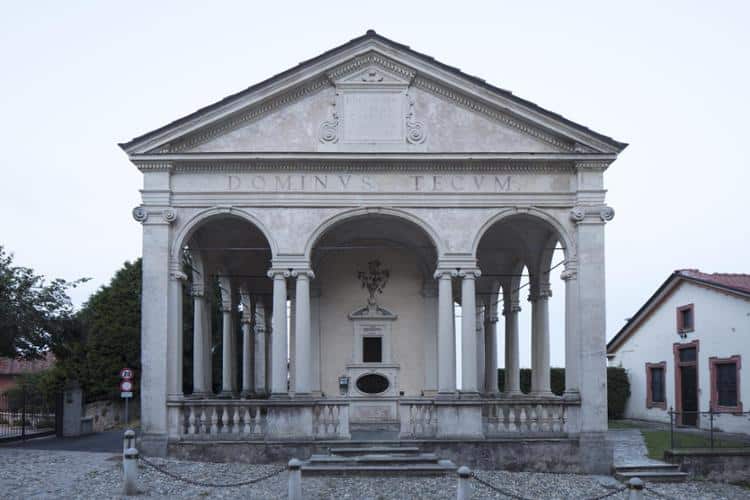
Chapel 1 — The annunciation
The reconstruction in the first chapel represents a typical early 17th-century house of the Lombardy region. The Virgin Mary stands next to a bed as the Archangel Gabriel shares the news that she will bear a son through a virgin birth.
Chapel 2 — The visitation
The second chapel depicts Mary visiting her cousin Elisabeth. Both are pregnant — Mary with Jesus, and Elisabeth with John the Baptist. Among the statues are also a festive dog, a donkey, and a blind violinist.
Chapel 3 — The nativity
Unsurprisingly, this chapel shows the nativity scene that is so well-known among Christians and that is all-present around Christmas. Jesus lies in the manger, surrounded by several figures and animals.
Chapel 4 — Presentation of Jesus at the temple
In the fourth chapel, Mary presents the baby Jesus to the priest Simeon. On the left side you can also see a thief trying to steal some coins and a dog watching the scene unfold.
Chapel 5 — Religious leaders challenge Jesus at the temple
The fifth chapel — the last dedicated to the Joyful Mysteries — depicts Jesus at the temple, sitting in the midst of the teachers.
Chapels dedicated to the Sorrowful Mysteries (6 – 10)
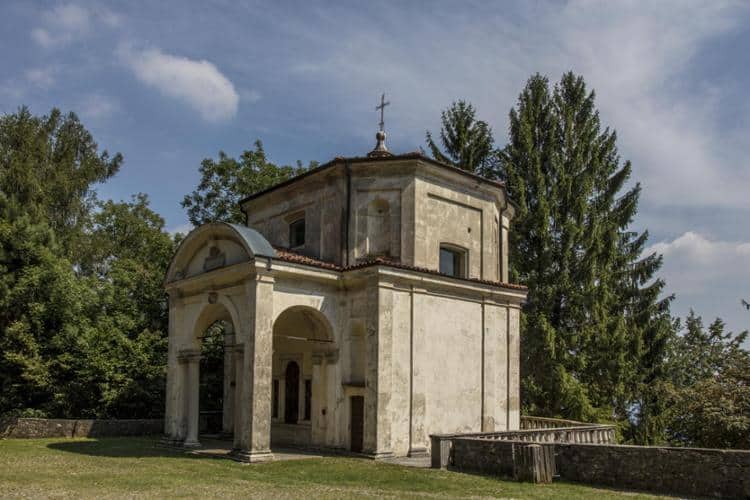
Chapel 6 — Jesus praying in the garden
This chapel shows Jesus side-by-side with the angel offering him the chalice of the Passion. On the right are Peter, James and John, sleeping, and on the left is a threatening group led by Judas.
Chapel 7 — The flagellation of Christ
In this chapel, Jesus is undressed, tied to a column and dragged to flagellation. Villains with grotesque shapes attack him, as Caiaphas and Jesus Barabbas stand by.
Chapel 8 — The crowning with thorns
The eighth chapel depicts the crowning of Jesus by his captors, who use the crown of thorns to cause him pain and to mock his claim of authority.
Chapel 9 — The ascent to Calvary
This chapel shows Jesus on his way to Calvary — the site of his eventual crucifixion, just outside Jerusalem. Jesus is bearing the cross while two villains press him.
Chapel 10 — The crucifixion
Possibly the most famous scene from Christian theology, the tenth chapel shows the crucifixion of Jesus. In this artistic rendition, Jesus is about to be hoisted on a very high wooden cross.
Chapels dedicated to the Glorious Mysteries (11 – 14)
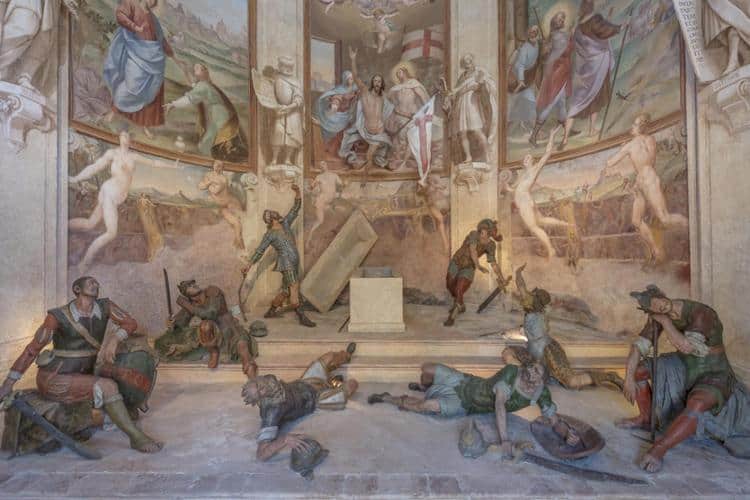
Chapel 11 — The resurrection
In this chapel, Jesus is standing in the centre, suspended, bearing the triumphant banner of the cross. The painted scenes behind Jesus depict Heaven and the several Apparitions of Jesus.
Chapel 12 — The ascension
In the twelfth chapel, the Virgin Mary and eleven of the Apostles watch Jesus physically ascend to Heaven, surrounded by golden rays.
Chapel 13 — The descent of the Holy Spirit
At the centre of the scene in this chapel are the Virgin Mary and the eleven Apostles, who receive the flame of the Holy Spirit alongside a white dove.
Chapel 14 — The assumption of Mary
In the last chapel, the Virgin Mary is rising to the sky at the end of her earthly life, accompanied by angels. She leaves behind an empty tomb and eleven incredulous Apostles.
The Sanctuary
The Sanctuary is dedicated to the final Mystery of the Rosary: the coronation of the Virgin Mary as the Queen of Heaven.
After climbing Sacro Monte di Varese: Santa Maria del Monte
At the foot of the Italian Alps and at the end of the climb lies Santa Maria del Monte, an autonomous municipality that now makes up part of Varese.
Santa Maria del Monte is the perfect place for you to relax after climbing the Sacro Monte and learning about its history. For example, you can walk along the winding cobbled alleyways, sip a coffee or have something to eat in one of the neighbourly restaurants sprawled among the village.
The main sights in Santa Maria del Monte are the ancient monastery of the Romite Ambrosiane, the Baroffio Museum and the Pogliaghi House-Museum.
From here, you can also take the funicular back to the start of the Sacro Monte.
You can also find more detailed information about Sacro Monte di Varese on the official website.
Thanks for reading!
-S
PIN IT!




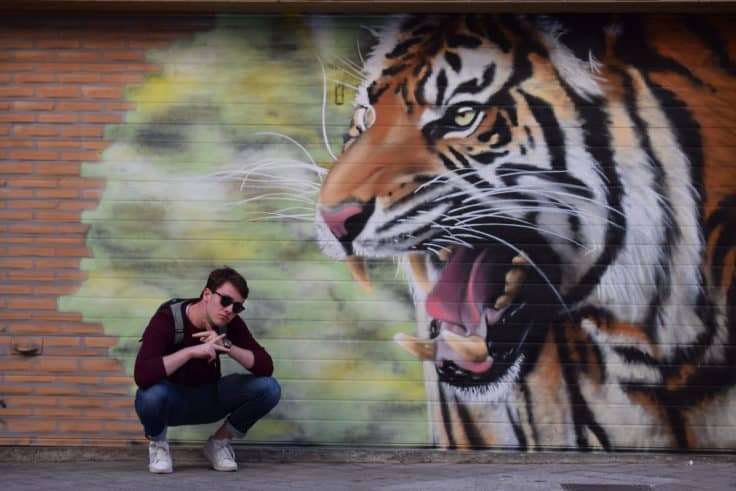


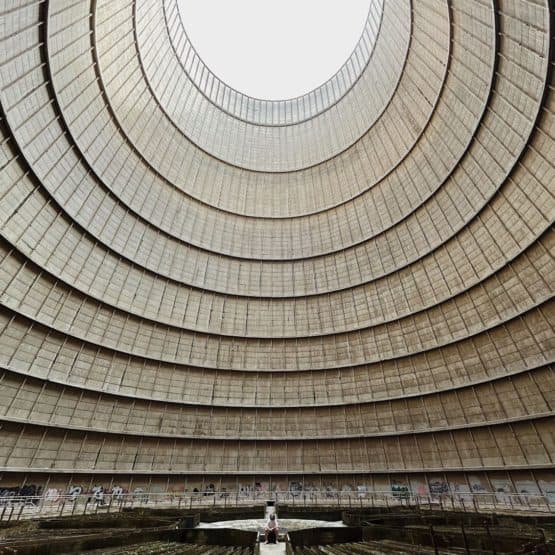
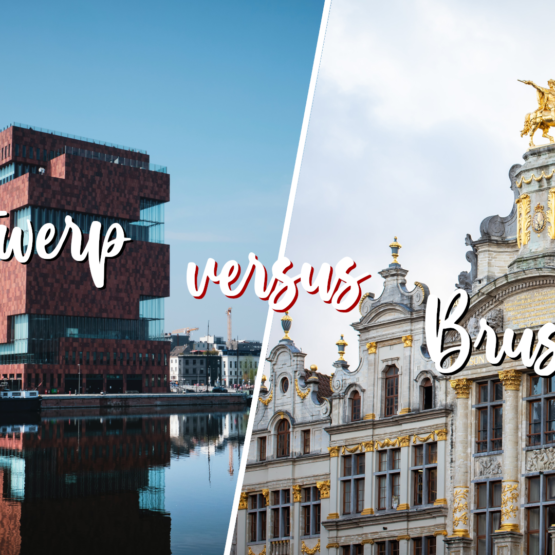
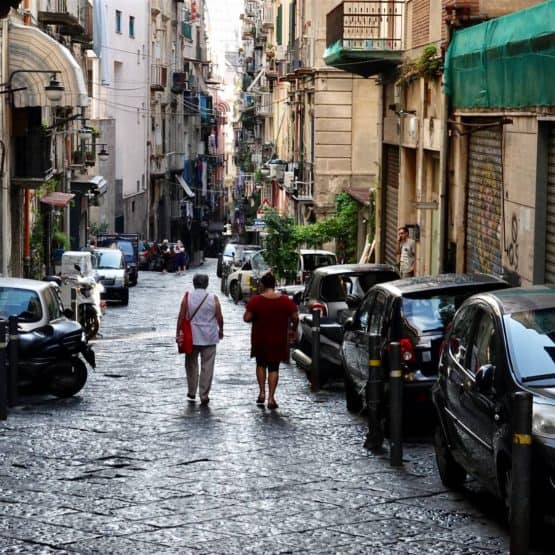
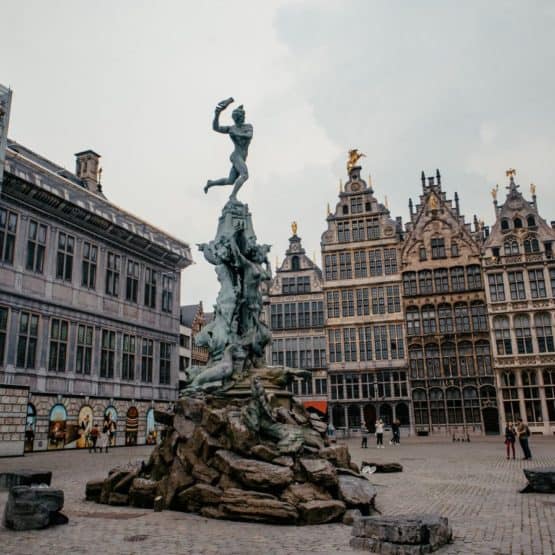
Laura
March 28, 2023 at 5:10 amSuper helpful! Thank you.